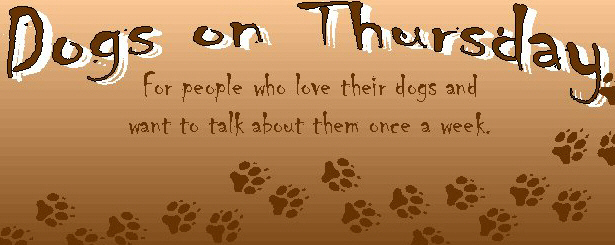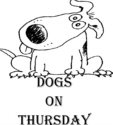Welcome to Dogs On Thursday. Recently a lot of people have expressed an interest in dog agility. It's a wonderful way to combine teamwork and play with your dog, but although it looks like fun, there are certain rules and pieces of equipment that are unfamiliar to some of us.
We are fortunate to have some members of DOT that compete in agility and have agreed to give us some information that may help us to to get some teams started.
Nicki and her dogs have earned a number of titles and she agreed to write about some basics for the rest of us. .jpg)
Agility is a sport where a handler guides their dog through a course of obstacles while racing against the clock and avoiding course faults. It's a great way to exercise, build your bond with your dog, build a dog's confidence, have fun, go to competitions and make new friends. Any dog can participate and compete in agility. There are several different organizations that offer agility competition and the rules on which age, size, breed or mix of dog may compete - but there is something for everyone. Many organizations even have special divisions for older dogs and older or handicapped handlers.
Any dog can participate and compete in agility. There are several different organizations that offer agility competition and the rules on which age, size, breed or mix of dog may compete - but there is something for everyone. Many organizations even have special divisions for older dogs and older or handicapped handlers.
Before getting started in agility it is helpful if your dog knows some basic commands such as sit, down, stay and comes reliably when called while off leash. It's also good to get your dog used to playing fetch and tugging on toys, as these are good motivators to get your dog revved up for agility, and to help teach them to work at a distance and move out ahead of you on the course.
The obstacles on an agility course can generally be divided into several catagories as follows:
Jumps: These can include the single bar jump, double and triple bar jumps, tire jump, broad jump and panel jump. The dog must not knock down any bars or panels, must not step on the broad jump, and must go through the tire.

Tunnels: These include the open or pipe tunnel and the closed tunnel or chute. The open tunnel can be straight or curved in a variety of shapes.
Contact Obstacles: These include the Dogwalk, A-Frame and Teeter. The dog must touch the yellow 'contact' zones on ends of the obstacle for correct performance. Only one toe needs to get in the yellow zone to count, but most handlers teach their dog using a method that rewards the dog for going all the way down - not just barely touching the yellow.
The teeter is the only moving obstacle and must be taught carefully as not to spook the dog.
Weave Poles: This is a line of 6 - 12 poles that the dog must weave in and out of. The dog must always enter with the first pole on his left. This is one of the harder obstacles to train..jpg)

Pause Table: This is a table on which the dog must perform either a sit or down for the count of five. The judge will announce ahead of time if it will be a sit or a down. The obstacles used may vary from one organization to the next, but will generally be some combination of the ones covered above. The height of the table and jumps changes with the size of the dog but the other obstacles stay the same. This can create special challenges for dogs that are very large or very small depending on the obstacle.
The obstacles used may vary from one organization to the next, but will generally be some combination of the ones covered above. The height of the table and jumps changes with the size of the dog but the other obstacles stay the same. This can create special challenges for dogs that are very large or very small depending on the obstacle.
In a competition setting a dog can earn qualifying scores and eventually obtain a title, and then move on to the next level of competition. This allows a dog to essentially compete against himself as well as the other dogs. As the dog gets to higher levels of competition the courses get longer and more difficult and the time allowed to complete the course becomes shorter. This means there are always new skills to work on and plenty of reasons to spend more time with your dog!
I want to thank Nicki for explaining the equipment and for the pictures of her Border Collie, Legend. The other wonderful models in the pictures were Boone, a Pyrenean Shepherd and Wicca,a Cardigan Welsh Corgi. Boone and Wicca belong to Amanda of Many Muddy Paws. She was kind enough to share her photos with us.
Be sure to visit the other DOT dogs and say hello.
Please note:
We hope that you enjoy the DOT posts and the different views from everyone included. We promise lots of cute pictures, laughter, maybe a tear or two, and some information. Please note that the views and opinions expressed here are each author's own and do not necessarily represent DOT as a whole.
Thursday, May 14, 2009
Agility Basics
Subscribe to:
Post Comments (Atom)

.JPG)
.JPG)
.JPG)
.JPG)













6 comments:
Yaayyy, we finally got round to playing! We have a video and a lovely sunset up :o)
Slobbers and Happy DOT!
I just love watching the dogs go through the obstacle courses. Have only seen them on tv, but it's really amazing what they do! Thanks for the neat post today! Great pics!
What a great post! I've lost hope for Sissy and agility - she's just too unreliable off-leash - but there's still Gretchen...
the post looks great!!! glad my dogs could be of help!!!
In our house we call this the Dog Olympics. We don't participate, but occasionally flip channels and catch some on TV.
Thank you Sue for covering for me this week - and GREAT post!!!!!!
Post a Comment